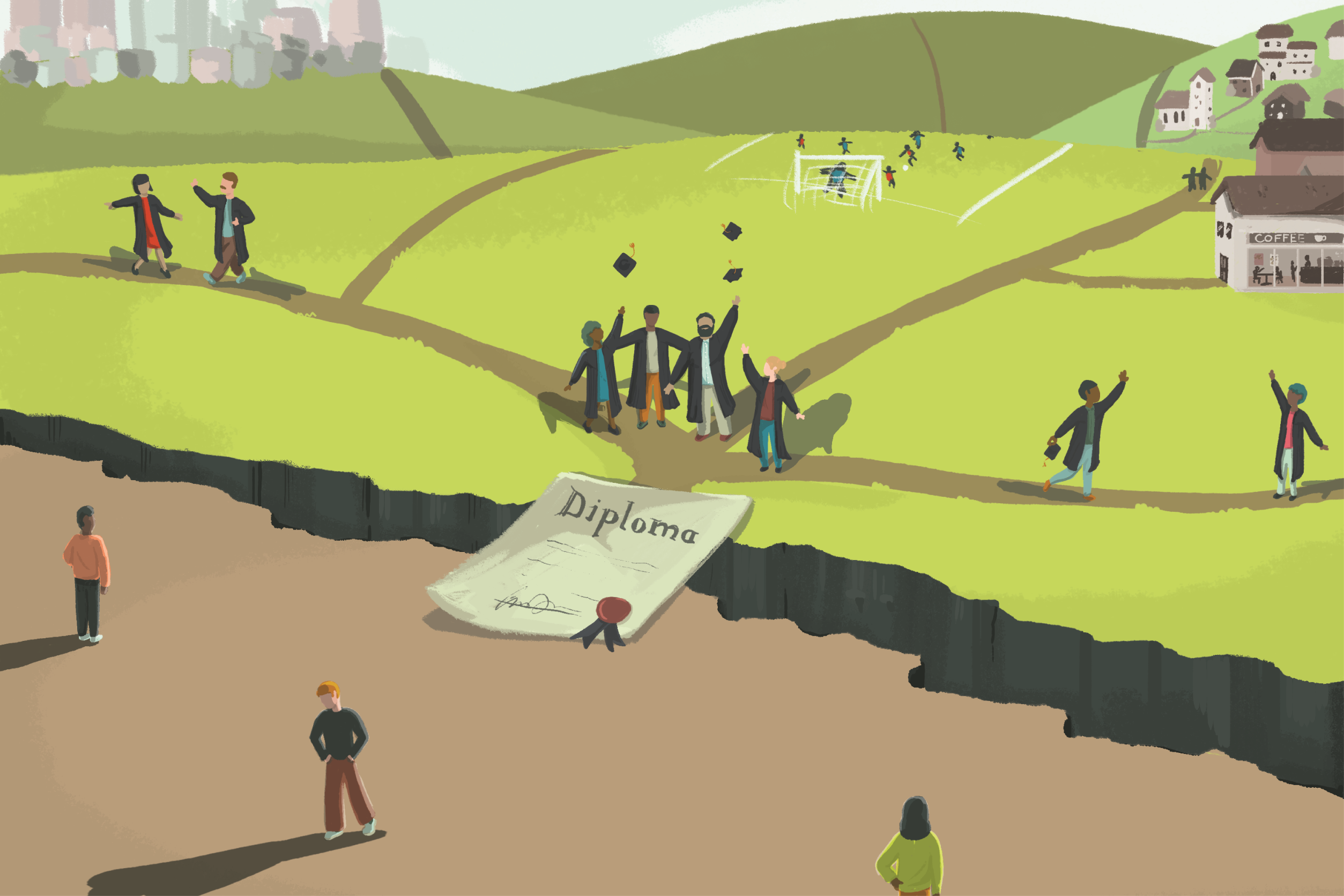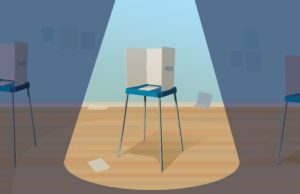December 13, 2021
The College Connection: The Education Divide in American Social and Community Life

Acknowledgments
The Survey Center on American Life of the American Enterprise Institute is grateful to the John S. and James L. Knight Foundation for its generous support of the American Community Life Survey.
In addition, the authors would like to thank Beatrice Lee, Dana Popky, and Alicia Nottrott for their research assistance and support with the design of the report figures, Sarah Burns and Josh Delk for their strategic insights and communications support, Abigail Guidera for her detailed oversight and administrative assistance, Curtis Harrison for his careful and efficient editing, and Danielle Curran and Jennifer Morretta for their design and aesthetic expertise.
Introduction
In a time of surging student loan debt, the benefits of a college education have once again become the subject of scrutiny and public debate. For younger Americans, the lesson of the Great Recession was that a four-year degree could no longer guarantee the career success and financial stability it once promised. What’s more, the cost of a college education has exploded, leaving many graduates facing mounting debts. Many Americans are now left wondering: Is a college degree worth it?
Amid this growing discussion, scholars, policy analysts, and legislators have been trying to quantify the financial advantage a secondary degree provides and measure its trade-offs. Despite concerns about rising student debt, the economic value of a college education is clear. Since the Great Recession, most of the jobs that have been created require a college degree, and the lifetime earnings of college graduates far outstrip those of Americans without a college education.[1]
But there is another reason a college education might be worthwhile, even without the evident financial advantages a degree offers. College graduates live increasingly different lives than those without a college degree. They are more socially connected, civically engaged, and active in their communities than those without a degree. I find that college graduates have more extensive systems of social support and a larger number of close friends. Consequently, they feel lonely and isolated less often.
Part of the reason for the divergence in social experiences between those with a college degree and those without is the decline in civic and social infrastructure that once served the needs of all Americans—but was particularly important for those without a college education. Today, Americans without a college education are far less likely to marry and become involved in religious life. Marriage and religious participation have been, and continue to be, strongly associated with greater social engagement and stronger community attachments.
In the wake of rising tuition costs and a marked shift in culture on college campuses, it makes sense to carefully weigh the benefits of a college education. But any analysis that does not take into account the profound social advantages a college education provides is missing a key part of what that education actually offers.
The Educational Divide in American Social Life
The lifetime earnings benefit that a college degree bestows on graduates is difficult to discount. But this is hardly the only advantage afforded to Americans who attend four-year colleges and universities.
College graduates express feelings of loneliness less often, have more close friendships, and report having more robust social activity than those without any college experience. In the US, recent work has documented a rise in feelings of loneliness and social isolation, experiences that became much more prevalent during the coronavirus pandemic and the reduced social contact it has imposed.[2] A college degree might enable Americans to not only weather financial challenges more easily and avail them of greater economic opportunities but also provide greater social and civic opportunities—a benefit that is difficult to quantify over a lifetime.
The Friendship Decline
Recent research reveals that the number of close friends Americans have has fallen dramatically over the past few decades.[3] However, while the “friendship recession” appears to be national, it has not affected all Americans equally. Some Americans appear to be suffering a much greater social deficit.
Americans without a college education today have experienced a much more dramatic decline in the size of their social circle than have those with four-year degrees. In 1990, Americans without a college degree had roughly as many close friends as those with a four-year college degree did. About six in 10 Americans without any college education (64 percent) and roughly as many college graduates (59 percent) had at least five close friends.[4]
More than 30 years later, Americans who graduated from college have larger friendship networks than those who did not graduate from college do. Although both groups report having fewer close friends today than they did in the past, Americans who never attended college have experienced a massive friendship decline. Today, nearly half (47 percent) of college-educated Americans have at least five close friends, compared to about one-third (34 percent) of those without a degree. Since 1990, the number of Americans without a college education who have five or more close friends has fallen 30 percentage points.
Smaller Social Networks
But the deficit of close friends among those without a college degree is only part of the picture. The social disparity is even worse if we look at the entire network of social ties that Americans have. A 2020 survey found that 17 percent of Americans reported having no close social connections—defined as someone you talked to about an important personal matter within the past six months.[5] Americans without a college degree were nearly three times more likely to have no close social ties than those with a college degree were. Nearly one in four (24 percent) Americans with no college education reported having no immediate social connections, compared to 9 percent of college graduates.
The Loneliness Gap
Not only do Americans without college degrees report having smaller social networks and fewer close friends, but feelings of loneliness are more common among those without a college education. Close to half (45 percent) of Americans without a college education report they have felt isolated from others at least sometimes in the past four weeks. College-educated Americans report experiencing these feelings less often; 36 percent say they have felt this way at least once in a while in the past month.
There is an even larger education divide in feelings of social support. Americans without a college degree are less likely than college graduates are to feel there are people in their lives they can count on. In the past month, nearly three-quarters (73 percent) of college graduates said they very often or often feel like they have people they can turn to. Fifty-six percent of Americans without a college degree say the same.
To more fully illustrate the education divide, I developed the social support scale—a composite index that combines three separate measures of social support: frequency with which people feel “there are people you can talk to,” “there are people you can turn to,” and “there are people you feel close to.” Overall, 59 percent of Americans have a high amount of social support in their lives. About one-third (32 percent) have a moderate degree of social support, and 9 percent have little social support.
The degree of social support Americans have varies considerably by education level. Two-thirds (66 percent) of college graduates have a high level of social support, compared to about half (52 percent) of those without a college degree.
Is It Just About Marriage?
Research on loneliness, social connection, and social support typically finds that married Americans fare better than their single or divorced counterparts. Married Americans have been found to have larger social networks, have more close friends, and report feeling lonely less often.[6]
Is it possible that the social benefits conferred by a college education are primarily due to differential marriage rates? Today, there is a large and growing marriage gap between those with a college education and those without. According to an analysis of US Census data by the Pew Research Center, nearly two-thirds (65 percent) of college-educated Americans age 25 or older are married, compared to half (50 percent) of those with a high school education or less. In 1990, the education divide in marriage was modest: 69 percent of Americans with a college degree were married, compared to 63 percent of those with no college education.[7] Over the next several decades, education became much more closely associated with marital status.
To answer this question and account for the influence of marital status, I ran two separate logistic regression models predicting feelings of loneliness and social support. Even after accounting for the impact of marital status, Americans without a college education are more likely to feel lonely and less likely to feel connected to and supported by others than college-educated Americans are.
The College Advantage
Americans with a college degree report having more extensive social connections than those without. One possible explanation for the discrepancy may lie with the fact that a college education may lead Americans to become more involved in civic affairs, politics, and social clubs, all of which increase their opportunities to develop social ties. Educational attainment has been shown to be strongly associated with membership in formal groups. Having a college degree increases the likelihood that one is a member of a book club, the Parent-Teacher Association, or a local civic group.[8] But college-educated Americans have an array of additional advantages when it comes to building and sustaining social connections.
Friendship Opportunities
One obvious advantage college-educated Americans have over those who never spent time on a college campus is the four years they spent developing social skills, pursuing friendships, and building a social network. School is one of the most important places Americans establish close friendships, and this happens much more frequently in college than in high school. Six in 10 (60 percent) four-year college graduates say they made a close friend at their alma mater. Only about one in three (35 percent) Americans who never attended college have a school-based friendship.
That’s not the only place where college-educated Americans have an advantage. Roughly one in four (24 percent) college-educated Americans report having made a close friend through a club or other type of membership organization, compared to 13 percent of those without a degree. Americans who went to college are far more likely to have made a close friend at their workplace—or their spouse’s or partner’s workplace—than those who did not attend university or college (62 percent vs. 47 percent). Instead, Americans who never went to college rely more on their neighborhood to make close friends; 40 percent report having developed a close social connection this way, compared to 29 percent of those with a college degree.
A Wealth of Weak Ties: Place-Based and Activity Friendships
Americans with a college degree have not only more close friends than those who never attended a college or university but also more informal friendships, often referred to as “weak ties.”[9] Although the importance of weak social connections has long been recognized, a growing body of work has demonstrated how weak social ties can boost emotional well-being and provide a sense of belonging.[10]
Perhaps due to having a greater abundance of free time or more extensive financial resources, college graduates are far more likely than those without a college education to report having place-based friends (defined as a friend they see only in certain places) or activity friends (defined as those they spend time with as part of a hobby group, team, or league). Seventy-eight percent of Americans with a college degree report having place-based friendships, compared to 62 percent of those with a high school degree. College graduates are also more likely to have activity-based friendships (60 percent vs. 41 percent).
These relationships are important. A wealth of evidence suggests that weak ties can be incredibly beneficial in keeping people connected to the labor market. In fact, most Americans find a job not through a spouse, close friend, or immediate family member but through a weak social tie.[11]
Social Integration and Friendship Diversity
When it comes to having diverse friendship groups, education does not appear to play much of a role in the racial diversity of social networks. Americans with a college education are not significantly more likely to have friends of a different race or ethnicity.[12] Roughly four in 10 Americans with a college degree (40 percent) and those without any college education (38 percent) report not having any close friends of a different race or ethnicity.
White Americans generally have fewer friends who belong to different racial or ethnic groups. But again, the degree of diversity among White Americans is nearly identical across levels of education. Roughly half of White Americans with a college degree (49 percent) and those without any college education (49 percent) have no friends of a different race or ethnicity.
Moreover, when it comes to Americans’ core social networks, a relationship category that includes close friends, family members, and other close connections, education has little impact on the diversity of social contacts.[13] Thirty-eight percent of Americans with a college degree and 35 percent of those without one have a core social network that is “racially diverse,” meaning it includes at least one person (out of a possible seven) who identifies with a different racial or ethnic group.
What does affect network diversity is the size of Americans’ social networks. Americans with a larger core social network have a greater likelihood of having a member who is a different race or ethnicity. For instance, 48 percent of Americans with at least seven members in their core social network have a close social tie of a different race or ethnicity, compared to 25 percent of those with two members in their core network.
Creating Community Spaces
Americans with a college degree demonstrate a greater propensity to join formal organizations—such as civic or political groups and social clubs—than those without a degree.[14] But they are more likely to develop their own informal social outlets as well. One of the crucial differences between Americans with a college degree and those without any college education is their access to and use of “third places”—local spots where they spend time when they are not at work or home, such as local parks, coffee shops, or bars. Two-thirds (66 percent) of Americans with a college degree report having such a place, while less than half (46 percent) of those without a college education say the same.
The benefits of having a third place are considerable. Having a third place—particularly one where you see people you know—is associated with a range of positive social outcomes, from feeling more connected to one’s neighbors to feeling less lonely, referred to as the “Cheers effect.”[15] Americans who have a third place also report having more close friends. More than half (53 percent) of Americans who have a third place frequented by people they know report having at least five close friends. Only 35 percent of those without a third place report having this many close friends.
Not only are college-educated Americans more likely to have a place in their community where they spend time, but they also visit these places more often. Among those who have a local place in their community, a majority (57 percent) of college-educated Americans report visiting at least once a week, compared to less than half (45 percent) of those without a college education.
Third places can take many forms. But regardless of the type of commercial space or public place, Americans with a college education simply spend more time in them. College graduates are twice as likely to visit a local bar at least once or twice a month (28 percent vs. 14 percent) and far more likely to visit a coffee shop (53 percent vs. 32 percent) or restaurant (73 percent vs. 54 percent) than those without a college education.
Given the often stark differences in their financial situations, it’s notable that the educational disparity is evident in public places too. Twenty-seven percent of college-educated Americans report visiting a library at least once or twice in the past month, compared to 17 percent of those without a college degree. And there is a nearly 20-percentage-point gap between how often college graduates and those without any college education frequent public parks (59 percent vs. 40 percent).
Connection to Community Leaders
Another benefit accrued by college graduates is their connection to community leaders—people who regularly coordinate neighborhood activities and events. Previous work has found that community leaders exist across racial, religious, and geographic divides and that knowing this type of person is associated with a number of positive social outcomes.[16]
Perhaps due to their more extensive social networks, college-educated Americans are far more likely to know a community leader. Nearly half (46 percent) of Americans with a college degree know someone who is very active in their neighborhood or community, while fewer than one in three (30 percent) of those without a college degree report knowing someone like this.
How Neighborhood Character Affects Neighborly Trust and Connection
The types of places where college-educated Americans live may offer them another advantage. The physical character of communities is linked to not only how we feel about where we live but also how trusting we are of local institutions and the people who live nearby. Americans living in neighborhoods suffering from neglect are far more likely to express feelings of social disconnection and mistrust.
Here again, a college education appears to imbue an advantage. College-educated Americans are less likely than those who are not college educated to live in neighborhoods that are less well taken care of and more likely to accrue the benefits that come with living in well-maintained places.
Trash, Litter, and Graffiti
One of the most visible manifestations of neighborhood neglect is litter, trash, and graffiti. While some neighborhoods might be more neglected than others, it is not uncommon to see litter, trash, and graffiti blighting streets and sidewalks, particularly in urban areas.
Overall, nearly four in 10 (38 percent) Americans report that they do not come across litter in the streets or sidewalks anywhere close to their home. Approximately one in three (32 percent) say they see litter or garbage on the streets in very few places where they live. Seventeen percent of the public say they see trash or graffiti in only certain areas, while 12 percent report seeing litter in a lot of places or everywhere in their neighborhood.
Fewer than one in 10 (8 percent) college graduates say they see trash or graffiti everywhere or in many places in their neighborhood. Americans with no college education are nearly twice as likely (15 percent) to say the same. Three-quarters (75 percent) of college-educated Americans say they see very little or no trash and graffiti in their neighborhoods, compared to about two-thirds (65 percent) of Americans with no college education.
Americans living in large metro areas are far more likely to see litter and graffiti. Twenty-eight percent of Americans living in a big city say there is litter, trash, or graffiti everywhere or in many places right around where they live. Fewer than one in 10 Americans living in the suburbs (8 percent), a town (8 percent), or a rural area (9 percent) say the same.
Simply seeing litter or broken glass strewn about the street may adversely affect how Americans feel about their community and the people who live there. Americans who say trash is everywhere in their neighborhood are far less likely to say their community is an excellent or good place to live than those who do not see any evidence of it near their home. Ninety-five percent of Americans who say there is no trash, litter, or graffiti anywhere near their home say their community is an excellent (43 percent) or good (52 percent) place to live. In stark contrast, Americans who say trash is everywhere are far less likely to say their community is excellent (7 percent) or good (29 percent).
Americans living in neighborhoods where trash and graffiti are common express far lower trust in their neighbors. Less than half (45 percent) of Americans who say garbage or litter are everywhere in their neighborhood say they have a great deal or a fair amount of trust in their neighbors. Eight in 10 (80 percent) Americans who live in places where there is no trash or graffiti nearby say they trust their neighbors at least a fair amount. This pattern holds across community types. Feelings of trust are higher in places without trash, litter, or graffiti marring the physical environment, whether that’s a dense urban neighborhood, a suburb, or a town.
Feelings of closeness to the people living around you is also much higher in areas free of garbage and graffiti. A majority (55 percent) of Americans living in places without any sign of garbage on the streets or sidewalks say they feel closely connected to their neighbors and neighborhood. This feeling is shared by only 36 percent of those living in places where trash is everywhere.
Safe Tap Water
But it’s not only the visible signs of neglect that undermine feelings of connectedness and trust. Americans who do not trust their tap water express greater dissatisfaction with their community, feel less closely connected to their neighbors, and are more distrusting of their local government.[17]
Here, the education gap is even more noteworthy. Overall, nearly half (47 percent) of the public report they would be uncomfortable drinking the tap water in their home, but views differ markedly by education. A majority (63 percent) of college graduates say they would be comfortable drinking the water in their home, while less than half (45 percent) of those without a degree say the same.
Differing views between college and noncollege Americans hold true across community type. Fifty-six percent of big-city residents with a college degree say they would be comfortable drinking their local tap water, compared to 43 percent of big-city residents who never attended college.
Americans who trust their tap water express a stronger connection to their community and the people who live there than those who do not trust their tap water. A majority (58 percent) of Americans who say they would be very comfortable drinking water from their tap say they feel closely connected to their neighborhood—a feeling shared by only 44 percent of those who say they would be very uncomfortable drinking unfiltered tap water.
Americans who trust their tap water are also more likely to feel positive about their community. Forty percent of Americans who are very comfortable drinking water from the tap say their community is an excellent place to live, a view shared by 26 percent of those who would be very uncomfortable drinking water from the tap.
The Difference Religious Communities Make
The widening gap in social connectedness between those with a college degree and those without may also be explained by the decline in religious participation and membership in the US. Past research has shown that Americans who are involved in a local congregation tend to be more active in their communities and participate more often in civic and political life.[18] Those who attend religious services more often have been found to have more extensive social connections than those who do not attend services.[19]
For many Americans, particularly those without access to other sources of social capital, religious communities serve as a crucial way of establishing enduring social bonds and providing a sense of belonging. And Americans without a college education have experienced a much more precipitous decline in religious membership than college graduates have.
The relationship between religion and educational attainment is complicated. College-educated Americans tend to express greater doubts about the existence of God, but they are much more likely to be formal members of a religious congregation.[20] According to Gallup, a majority (54 percent) of Americans with a college education report belonging to a religious congregation, compared to less than half (44 percent) of those without a degree.[21]
But the education gap in religious membership is a relatively recent phenomenon. In 1998, the gap in membership rates between those with a college degree and those without one was far smaller. Roughly seven in 10 (69 percent) college graduates and approximately two-thirds (65 percent) of those with a high school education or less reported being members of a local church or place of worship.[22]
Regardless of educational experience, Americans who belong to a religious congregation are much more active in community life and report stronger social connections. Overall, Americans who are members of a place of worship are much more likely than those who are not to volunteer in the community at least a few times a year (47 percent vs. 23 percent), talk to someone in their community they do not know well (64 percent vs. 54 percent), and attend a community meeting or local event (60 percent vs. 41 percent). They are also more likely than others to feel connected to their neighborhood and the people who live there (58 percent vs. 46 percent).
Religious involvement is particularly important for Americans without a college education. Among those without a college education, roughly half (48 percent) who belong to a religious congregation report attending a local event or community meeting at least a few times a year, compared to only 31 percent of those who are not members. Members of a religious congregation without a college degree are also more than twice as likely as nonmembers without degrees are to perform volunteer work in the community at least a few times per year (35 percent vs. 17 percent).
Neighborhood Churches
For many Americans, proximity to commercial and public space provides important benefits. Simply living near a public park, library, coffee shop, or bar is strongly associated with greater community engagement, higher feelings of social trust, and connection to the community.[23] Despite the centrality of religion in the lives of many Americans, living physically close to one’s local congregation does not seem to provide the same positive outcomes as living physically close to commercial and public space does.
Most religious Americans live fairly close to where they worship. Fifteen percent of the Americans who attend services at least seldom live within walking distance to their place of worship. Thirty-eight percent live within a 10-minute drive, and 27 percent live between 10 and 20 minutes away from their worship center. Twelve percent of Americans report having to take a 20- to 30-minute drive to reach their congregation, while only 6 percent say they have to travel at least 30 minutes to attend services.
Mormons stand out for living close to their churches. One in three (33 percent) Mormons report that their church is within walking distance. Americans who belong to other religious traditions tend to live farther away from where they worship. No more than one in four Hispanic Catholics (25 percent), White Catholics (16 percent), Jews (16 percent), Black Protestants (13 percent), White mainline Protestants (11 percent), and White evangelical Protestants (9 percent) report living within walking distance of their church.
Membership to a neighborhood church or congregation may increase feelings of connectedness. Sixty-nine percent of Americans who belong to a neighborhood church—that is, a church within walking distance—say they feel closely connected to their neighborhood. Less than half (40 percent) of those who belong to a church that is 30- to 60-minutes away say the same.[24]
Despite increased feelings of connectedness, the overall benefits of attending a neighborhood church are modest. Attending a neighborhood church does not increase positive feelings about the overall community. Americans who live within walking distance of where they worship are also not any more likely to volunteer in their community.
What’s more, living close to your church does not appear to facilitate more regular attendance. Americans who live within walking distance to their church or congregation report attending less frequently than those who live much farther away. Thirty-six percent of Americans who attend churches within walking distance report participating in religious services at least once a week. Americans who face a 30- to 60-minute drive to their church report higher rates of attendance; close to half (45 percent) attend at least once a week.
Rather than proximity to houses of worship, what appears to increase the probability of broader social and community participation is religious involvement. Americans who attend religious services more often are far more likely to engage in other social and community activities. Forty-one percent of Americans who attend services more than once a week report volunteering regularly—at least once or twice a month. In contrast, volunteer activity is much less common among those who seldom or never attend religious services. In fact, 62 percent of Americans who never attend religious services say they do not ever volunteer in their community.
Americans who attend services more often report having more religious-based friendships as well. Nearly nine in 10 (87 percent) Americans who attend services more than once a week have a close friend at their place of worship, while less than half (47 percent) of those who attend once or twice a month have a close friend there. These friendships are not limited to formal religious activities. Americans who regularly attend services are much more likely to spend time with their fellow members outside of formal services at least once a week. More than half (55 percent) of those who attend services more than once a week socialize with other members of their church or place of worship outside of normal services at least weekly. Those who attend just once or twice a month are far less likely to do so; only 15 percent spend time with members of their congregation weekly or more.
Diversity in the Pews
In most American congregations and worship centers, the promise of racial diversity has been unrealized. Previous work has shown that Americans primarily worship in segregated spaces.[25] This remains true today. Overall, two-thirds (66 percent) of Americans who belong to a place of worship report that most people there share their racial or ethnic background.
For the most part, Americans who attend religious services at least a few times a year report that their congregation is not very diverse. Among White Americans, 77 percent attend services where most, if not all, of their fellow congregants are also White. The story is nearly identical for Black Americans: 76 percent attend services where most, if not all, other attendees are Black. Hispanic Americans remain an important exception. Only 39 percent of Hispanics report that their fellow congregants are all or mostly Hispanic. Eighteen percent of Hispanics attend services at churches with mostly White congregants, and 29 percent say that in their congregation, no one racial group makes up a majority.
Religious Americans with more years of formal education are more likely to attend services at less-diverse churches and places of worship. Nearly one-quarter (23 percent) of Americans with a high school education or less report that no racial group makes up the majority of congregants where they attend most often. Among college graduates, only 15 percent attend services at this type of church or place of worship.
This disparity is especially wide among White Americans. Eighty-four percent of White college graduates attend services where most or all of the congregants are White. In contrast, 69 percent of White Americans without a college education say their congregation is primarily or entirely White. White Americans with a high school education or less are more than twice as likely to attend a racially diverse congregation as those with a college degree (26 percent vs. 12 percent).
Conclusion
A college education is a major investment that should be made with careful consideration. More Americans are starting to doubt the efficacy of a college education—despite the accumulation of evidence showing the financial advantages it provides throughout a career.[26] But these cost-benefit analyses of higher education fail to take into account the immensity of the social benefits associated with higher education and risk providing an incomplete picture. The additional financial benefits that college graduates accrue throughout their careers is substantial, but the social advantages that come with a college degree may ultimately prove more impactful.
The disparity between college-educated Americans and those without college degrees also suggests a need for intervention to prevent further social and civic decline among those without degrees. In 2020, most Americans graduating from high school would not go on to attend a four-year college or university.[27] For those who chose not to or are unable to go to college, the future looks increasingly bleak. The decline of religious participation, the deterioration of associational life, and the collapse of marriage are all likely contributing to greater rates of social alienation and isolation among those who never attended college. Finding ways to adapt these seminal institutions or replacing them with attractive alternatives will be the key to providing social outlets and opportunities to increase social connectedness—and encouraging greater civic engagement and community life.
About the Author
Daniel A. Cox is a senior fellow in polling and public opinion at the American Enterprise Institute and the director of the Survey Center on American Life. He specializes in survey research, politics, youth culture and identity, and religion.
Notes
[1] Anthony P. Carnevale, Tamara Jayasundera, and Artem Gulish, America’s Divided Recovery: College Haves and Have-Nots, Georgetown University, McCourt School of Public Policy, Center on Education and the Workforce, 2016, https://1gyhoq479ufd3yna29x7ubjn-wpengine.netdna-ssl.com/wp-content/uploads/Americas-Divided-Recovery-web.pdf ; and Anthony P. Carnevale, Stephen J. Rose, and Ban Cheah, The College Payoff: Education, Occupations, Lifetime Earnings, Georgetown University, McCourt School of Public Policy, Center on Education and the Workforce, 2011, https://1gyhoq479ufd3yna29x7ubjn-wpengine.netdna-ssl.com/wp-content/uploads/collegepayoff-completed.pdf. For the purposes of this report, “college educated” refers to Americans with at least a bachelor’s degree, while “those without a college education” refers to those with a high school diploma or less. Respondents with some college education, a degree from a vocational school, or those with a two-year degree were excluded from this report.
[2] Alexi Quintana et al., “The COVID States Project #55: Social Isolation During the COVID-19 Pandemic,” Northeastern University, Harvard University, Rutgers University, and Northwestern University, July 6, 2021, https://osf.io/pfxnv/.
[3] Daniel A, Cox, “The State of American Friendship: Change, Challenges, and Loss,” AEI Survey Center on American Life, June 8, 2021, https://www.americansurveycenter.org/research/the-state-of-american-friendship-change-challenges-and-loss/.
[4] Gallup Organization and Cornell University, Roper Center for Public Opinion Research, “Gallup News Service Poll: January 1990, Wave 2,” 1990, https://doi.org/10.25940/ROPER-31088676.
[5] Daniel A. Cox et al., “Socially Distant: How Our Divided Social Networks Explain Our Politics,” AEI Survey Center on American Life, September 30, 2020, https://www.americansurveycenter.org/research/socially-distant-how-our-divided-social-networks-explain-our-politics/.
[6] Daniel A. Cox et al., “Socially Distant: How Our Divided Social Networks Explain Our Politics”; and
Daniel A, Cox, “Can Married Men and Women Be Friends? Marriage, Friendship, and Loneliness,” Institute for Family Studies, July 20, 2021, https://ifstudies.org/blog/can-married-men-and-women-be-friends-marriage-friendship-and-loneliness.
[7] Kim Parker and Renee Stepler, “As U.S. Marriage Rate Hovers at 50%, Education Gap in Marital Status Widens,”Pew Research Center, September 14, 2017, https://www.pewresearch.org/fact-tank/2017/09/14/as-u-s-marriage-rate-hovers-at-50-education-gap-in-marital-status-widens/.
[8] Daniel A. Cox, “After the Ballots Are Counted: Conspiracies, Political Violence, and American Exceptionalism,” AEI Survey Center on American Life, February 11, 2021, https://www.americansurveycenter.org/research/after-the-ballots-are-counted-conspiracies-political-violence-and-american-exceptionalism/.
[9] Mark S. Granovetter, “The Strength of Weak Ties,” American Journal of Sociology 78, no. 6 (May 1978): 1360–80, https://www.jstor.org/stable/2776392?seq=1#metadata_info_tab_contents.
[10] Gillian M. Sandstrom and Elizabeth W. Dunn, “Social Interactions and Well-Being: The Surprising Power of Weak Ties,” Personality and Social Psychology Bulletin 40, no. 7(2014): 910–22,https://journals.sagepub.com/doi/abs/10.1177/0146167214529799.
[11] Moira Burke, Jason J. Jones, and Laura K. Gee, “How Strong and Weak Ties Help You Find a Job,”Facebook Research, March 31, 2016, https://research.fb.com/blog/2016/03/how-strong-and-weak-ties-help-you-find-a-job/.
[12] The racial diversity of friendship groups was calculated from a battery of questions asking Americans to report whether they have any close friends who are “white,” “black,” “Hispanic,” or “Asian or pacific islander.” This question was asked to respondents in written form. To determine diversity of a respondent’s friendship group, these responses were then compared to the respondent’s own reported race or ethnicity.
[13] This analysis excluded those who report having no one in their social network.
[14] Aleksandra Sandstrom and Becka A. Alper, “Americans With Higher Education and Income Are More Likely to be Involved in Community Groups,” Pew Research Center, February 22, 2019, https://www.pewresearch.org/fact-tank/2019/02/22/americans-with-higher-education-and-income-are-more-likely-to-be-involved-in-community-groups/.
[15] The Cheers effect is the effect of having a place where you recognize others and they recognize you, in reference to the sitcom Cheers.
[16] Daniel A. Cox et al., “Public Places and Commercial Spaces: How Neighborhood Amenities Foster Trust and Connection in American Communities,” AEI Survey Center on American Life, October 20, 2021, https://www.americansurveycenter.org/research/public-places-and-commercial-spaces-how-neighborhood-amenities-foster-trust-and-connection-in-american-communities/.
[17] Daniel A. Cox et al., “Public Places and Commercial Spaces.”
[18] Jim Jansen, “The Civic and Community Engagement of Religiously Active Americans,”Pew Research Center,December 23, 2011, https://www.pewresearch.org/internet/2011/12/23/the-civic-and-community-engagement-of-religiously-active-americans/.
[19] Orestes P. Hastings, “Not a Lonely Crowd? Social Connectedness, Religious Service Attendance, and the Spiritual but Not Religious,” Social Science Research (May 2016): 63–79, https://pubmed.ncbi.nlm.nih.gov/26973032/.
[20] Daniel A. Cox, “Religious Diversity and Change in American Social Networks: How Our Social Connections Shape Religius Beliefs and Behaviors,” AEI Survey Center on American Life, December 15, 2020, https://www.americansurveycenter.org/research/religious-diversity-and-change-in-american-social-networks/.
[21] Jeffery M Jones, “U.S. Church Membership Falls Below Majority for First Time,”Gallup, March 29, 2021, https://news.gallup.com/poll/341963/church-membership-falls-below-majority-first-time.aspx .
[22] This analysis was conducted using data from the Gallup Poll Social Series between 1998–2020. Respondents with some college education were excluded from this analysis.
[23] Daniel A. Cox et al., “Public Places and Commercial Spaces.”
[24] This analysis is based on a group that includes fewer than 100 respondents (n = 84), and the results should be interpreted with some caution.
[25] Michael Lipka, “Many U.S. Congregations Are Still Racially Segregated, but Things Are Changing,” Pew Research Center, December 8, 2014, https://www.pewresearch.org/fact-tank/2014/12/08/many-u-s-congregations-are-still-racially-segregated-but-things-are-changing-2/.
[26] Stephanie Marken, “Half in U.S. Now Consider College Education Very Important,” Gallup, December 30, 2019, https://www.gallup.com/education/272228/half-consider-college-education-important.aspx; and Kat Tretina, “Is College Worth the Cost? Pros. Vs. Cons,” Forbes, March 31, 2021, https://www.forbes.com/advisor/student-loans/is-college-worth-it/.
[27] ThinkImpact, “High School Graduates That Go to College,” 2021, https://www.thinkimpact.com/high-school-graduates-that-go-to-college/.
Related Materials
American Community Life Survey Topline








